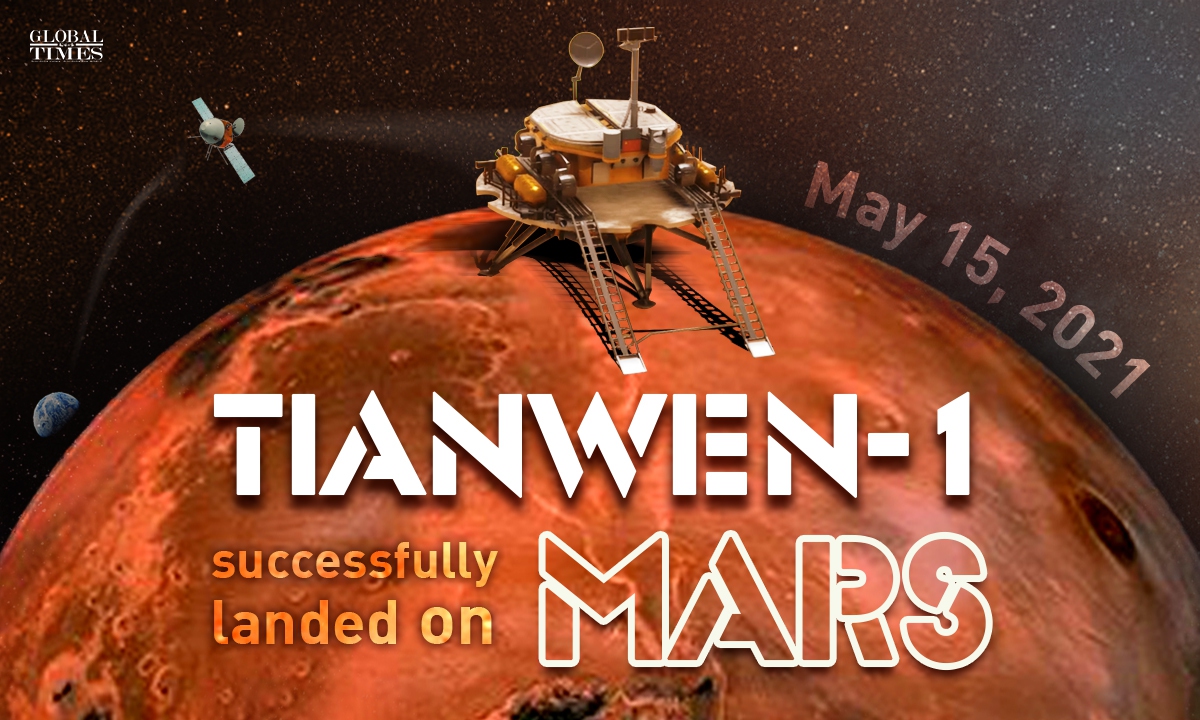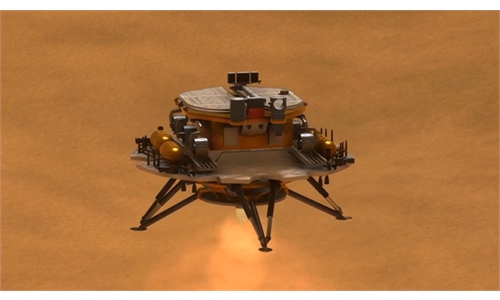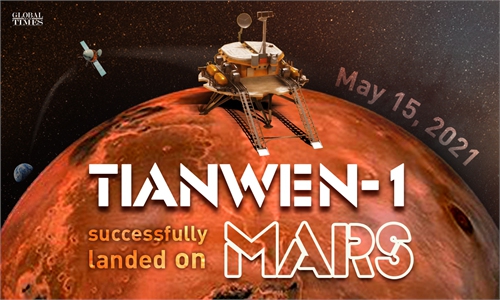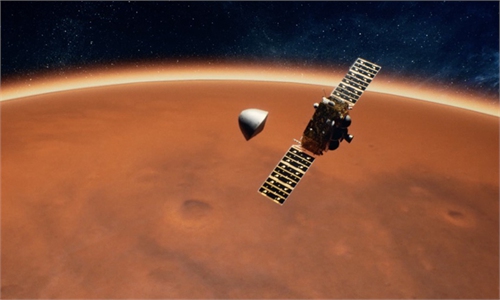More Tianwen-series probes to collect samples from Mars for research: chief designer
Chinese expected to reach Red Planet, more interplanetary expeditions to enhance national power: experts

Tianwen-1 successfully landed on Mars Infographic: GT
As Zhurong Mars rover embarks on its mission to explore the surface of the Red Planet for at least 3 Martian months, approximately 92 days on Earth, the chief designer of China's first Mars exploration mission shared the vision for the next goals under a national plan called "planetary exploration," which is to send more Tianwen-series probes to planets, including Mars and Jupiter, to collect samples and carry out key technology research.
The touchdown of the Tianwen-1 probe on Mars - which marks that China has become the third nation to achieve such a feat, following Russia and the US - may be far from enough for China's ambition for interplanetary expedition, as China is expected to send humans to Mars and launch more interplanetary missions to enhance people's knowledge of the unknown and improve the capacity of the country, Chinese space observers told the Global Times on Monday.
Aiming to achieve "orbiting, landing and roving" all in one mission, China's Tianwen-1 probe, which touched down successfully, has entered its exploration phase.
Named after an ancient fire god of Chinese mythology, the 1.85-meter-tall and 240-kilogram Zhurong Mars rover has been deployed after successful soft-landing at the planned site in the southern part of a vast plain known as Utopia Planitia on Mars early Saturday morning.
The probe landed on the Red Planet at a selected time between early Saturday morning and Wednesday, the China National Space Administration (CNSA) announced on Friday afternoon.
Six scientific payloads - a pair of navigation and terrain cameras, a multispectral camera, a Mars surface composition detector, a penetrating radar, a mast-mounted magnetometer and a Mars climate station - were installed on Zhurong to study the topography, geology, soil structure, minerals and rock types and atmosphere.
The orbiter will not only provide relay communications for the rover, but also cover the entire planet in about two years, Zhang Rongqiao, chief designer of China's first Mars exploration mission, said in an interview on China Central Television (CCTV), China's state broadcaster, on Saturday. Zhang noted that the orbiter will probe the entire planet's topography, space environment and internal structure.
As the Tianwen-1 has landed successfully, which is regarded as only a step away from the final completion of this Mars mission, Zhang said the next is to send Tianwen-2, Tianwen-3 and more probes to Mars and other planets such as Jupiter to explore and collect samples, which is under a national project called "planetary exploration."
"We will carry out research on key technologies so we can return samples from Mars in the early stages and further solidify our key technologies," Zhang said.
Zhang said they are pushing ahead with filing the "planetary exploration" project for approval which has been included in China's future development.
"Once the project is approved by the country, we will try our best to complete it as soon as possible in accordance with the 'Chinese speed'," Zhang said.
Wang Ya'nan, chief editor of Aerospace Knowledge magazine, believes that the successful landing of Tianwen-1 on Mars has spectacularly conquered a new major milestone, and China is likely to send humans to Mars in the future.
Wang told the Global Times on Sunday that it took China more than 30 years from the launch of its first man-made satellite in 1970 to the launch of the first manned space mission, Shenzhou-5, in 2003. Then in the past 17 to 18 years China has embarked on more frequent space science and technology innovation activities and achieved much more than in the 30 years before Shenzhou-5.
"China's space industry is going deep, to more distant space," Wang noted.
Wang believes that the space expedition goes from near orbit to deep space - the space station, the moon that is 380,000 kilometers from Earth, a manned lunar landing, then Mars, and further to the planetary system space of other bodies.
The most important factor contributing to China's huge achievements in the space industry is that the country has a strong determination to follow its innovation strategy of science and technology, including space, and the pace has not been slackened by any changes in the domestic and international environment, Wang said.
Zhang stressed in the CCTV interview that "We must advance our technology, cultivate our talents, and enhance our knowledge of the unknown world through these major forward-looking scientific explorations."
The successful touchdown of Tianwen-1 took place on the 295th day of its journey after it was launched and sent into planned orbit via a Long March-5 carrier rocket from Wenchang Spaceport in South China's Hainan Province on July 23, 2020.




